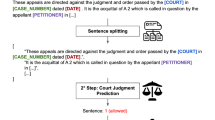Abstract
This paper aims to provide a cognitive computing framework to meet the challenges of semantic understanding, knowledge learning and judicial reasoning in the Chinese legal domain. In our framework, legal factors are first represented in a formal way; secondly, legal factors are extracted, and concepts and their relations are augmented with a combination of rule-based and deep learning methods; thirdly, a predication model is generated and trained to make judicial decisions. When a fact description is brought into the model, the probability of judicial decisions will be given automatically. Two elementary results are obtained: I. Our method can effectively predict the decisions for divorce cases with different expression styles, and offers better performance than traditional methods like Support Vector Machine (SVM); II. Our machine learning predicting results can be easily understood by general public as applied induction rules are given.



Similar content being viewed by others
Change history
19 November 2019
The Publisher regrets an error on the printed front cover of the October 2019 issue. The issue numbers were incorrectly listed as Volume 91, Nos. 10-12, October 2019. The correct number should be: "Volume 91, No. 10, October 2019"
References
Lin, W.-C., Kuo, T.-T., Chang, T.-J. (2012). Exploiting machine learning models for Chinese legal documents labeling, case classification, and sentencing prediction. ROCLING XXIV (pp. 140).
Liu, Y.-H., Chen, Y.-L., Ho, W.-L. (2015). Predicting associated statutes for legal problems. Information Processing and Management, 51(1), 194C211.
Aletras, N., Tsarapatsanis, D., Preotiuc-Pietro, D., Lampos, V. (2016). Predicting judicial decisions of the European court of human rights: A natural language processing perspective. PeerJ Computer Science, 2, e93.
Luo, B., Feng, Y., Xu, J., Zhang, X., Zhao, D. (2017). Learning to predict charges for criminal cases with legal basis. Conference on Empirical Methods in Natural Language Processing (pp. 2727–2736).
Kelly, I. E. (2015). Computing cognition and the future of knowing. IBM Research: Cognitive Computing. IBM Corporation.
Ludwig, L. (2013). Extended Artificial Memory. Toward an integral cognitive theory of memory and technology. Technische University Kaiserslautern.
Ferrucci, D.A. (2012). Introduction to ”this is watson”. IBM Journal of Research and Development, 56(3), 1.
Chen, Y.-L., Liu, Y.-H., Ho, W.-L. (2013). A text mining approach to assist the general public in the retrieval of legal documents. JASIST, 64(2), 280C290.
Raghav, K., Reddy, P.B., Reddy, V.B., Reddy, P.K. (2015). Text and citations based cluster analysis of legal judgments. In MIKE (pp. 449C459). Springer.
Raghav, K., Reddy, P.K., Reddy, V.B. (2016). Analyzing the extraction of relevant legal judgments using paragraph-level and citation information. AI4JCArtificial Intelligence for Justice (pp. 30).
Kim, M.-Y., Xu, Y., Goebel, R. (2014). Legal question answering using ranking svm and syntactic/semantic similarity. In JSAI International Symposium on Artificial Intelligence (pp. 244C258). Springer.
Carvalho, D., Nguyen, M.-T., Tran, C.-X., Nguyen, M.-L. (2016). Lexical-morphological modeling for legal text analysis. New Frontiers in Artificial Intelligence (Lecture Notes in Artificial Intelligence), 10091. https://doi.org/10.1007/978-3-319-50953-2.
Liu, C.-L., & Liao, T.-M. (2005). Classifying criminal charges in chinese for web-based legal services. In Asia-PacificWeb Conference (pp. 64C75), Springer.
Liu, C.-L., Chang, C.-T., Ho, J.-H. (2004). Case instance generation and refinement for case-based criminal summary judgments in chinese. Journal of Information Science and Engineering, 20(4), 783C800.
Liu, C.-L., & Hsieh, C.-D. (2006). Exploring phrase-based classification of judicial documents for criminal charges in chinese. In International Symposium on Methodologies for Intelligent Systems (pp. 681C690). Springer.
Sim, Y, Rouledge, B, Smith, NA. (2014). The Utility of Text: The Case of Amicus Briefs and the Supreme Court. Eprint Arxiv.
Katz, D.M., Bommarito, I.I., Michael, J., Blackman, J. (2016). A general approach for predicting the behavior of the supreme court of the United States. arXiv:1612.03473.
Li, J., Li, X., Meng, T. (2015). TML: A General High-performance Text Mining Language[J]. Computer Research and Development, 52(3), 553–560.
Mikolov, T, Chen, K, Corrado, G, Dean, J. (2013). Efficient Estimation of Word Representations in Vector Space[J]. Computer Science.
Zhai, F, Potdar, S, Xiang, B, Zhou, B. (2017). Neural Models for Sequence Chunking. AAAI.
Ma, X., & Hovy, E. (2016). End-to-end Sequence Labeling via Bi-directional LSTM-CNNs-CRF [J]. ACL.
Zeng, D.J., Liu, K., Lai, S.W., Zhou, G., Zhao, J. (2014). Relation classification via convolutional deep neural network. In The 25th international conference on computational linguistics (COLING2014) (pp. 2335–2344).
Singla, P., & Domingos, P. Discriminative training of Markov logic networks. In National Conference on Artificial Intelligence (pp. 868–873). AAAI.
Acknowledgements
This work is supported by national high technology research and development plans (863 plan) (No.2013AA064303).
Author information
Authors and Affiliations
Corresponding author
Additional information
Publisher’s Note
Springer Nature remains neutral with regard to jurisdictional claims in published maps and institutional affiliations.
Rights and permissions
About this article
Cite this article
Li, J., Zhang, G., Yu, L. et al. Research and Design on Cognitive Computing Framework for Predicting Judicial Decisions. J Sign Process Syst 91, 1159–1167 (2019). https://doi.org/10.1007/s11265-018-1429-9
Received:
Revised:
Accepted:
Published:
Issue Date:
DOI: https://doi.org/10.1007/s11265-018-1429-9




